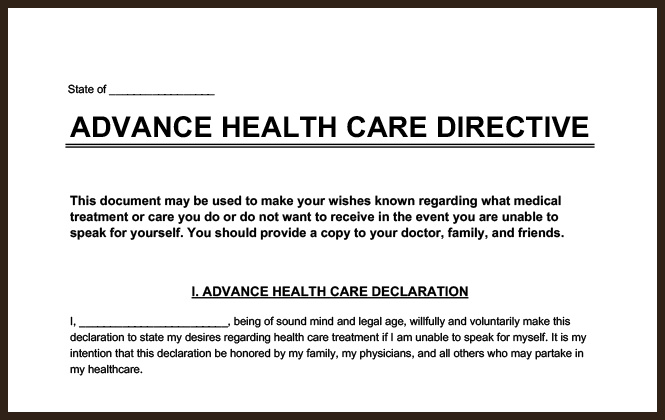An advance directive is a legal document that outlines a person’s preferences and instructions for medical treatment in the event they become unable to make their own decisions due to illness, injury, or incapacity.
Sometimes referred to as “living wills”, they allow people to specify what type of care they would like to receive or not receive if certain medical situations arise, such as life support or resuscitation measures.
Advance directives can also include instructions on end-of-life care, organ donation preferences, and appointing a healthcare proxy to make decisions on their behalf.
The laws relating to advance directives vary by state (and, of course, by country). As such, I recommended seeking advice from a lawyer (and certainly your from doctor or medical professional) before creating one.
Please note: The information provided in this article is for general US legal system informational purposes only and is not legal advice. This article does not create an attorney-client relationship between the reader and the author, nor should it be relied upon as a substitute for legal advice regarding your specific situation.
In This Article
What Do Advance Directives Contain?

Advance directives can vary, but they typically include the following:
Durable Power of Attorney for Healthcare
A section appointing someone (known as a surrogate, attorney, agent, or proxy) to make medical decisions on a persons behalf if they are unable to do so (e.g. they do not have capacity).
Living Will
A living will outlines a person’s preferences for medical treatment, such as whether or not they want life-sustaining measures taken in the event of a terminal illness or injury.
It guides medical professionals in making decisions about a patient’s care when they are not in a position to express them themselves.
Common types of medical treatment included in a living will, beyond DNR that I expand on below, include ventilation, tube feeding, what medicine a patient will receive, and whether they will receive blood transfusions (this is a big deal for some religions).
Do Not Resuscitate (DNR) Order

Although usually a separate document, some states include a DNR option in advance directions. A DNR instructs healthcare professionals not to perform CPR on someone if their heart stops beating or they stop breathing.
Organ Donation/Mental Health Treatment Instructions
Many advance directives include information about organ donation and whether a person wishes to donate their organs after death.
Some people may wish to specify their preferences for psychiatric or mental health treatments in their advance directive as well.
While there are naturally some limitations, taken as a whole, an advance directive is an avenue through which a person can protect their personal autonomy in relation to medical care and treatment. This is a significant ethical principle in modern medicine.
Of course, they are high stake documents, so it’s ensure they are clear and specific. Vague language can lead to confusion and conflict between family members (and, in some cases, medical professionals!). This is why I always reccomend dicussing these matters with a lawyer.
Do I Need an Advance Directive?
In the USA, there are no federal or state laws (Note: PDF Link) making having an advance directive compulsory. However, in any serious medical situations or as part end-of-life planning care, you can expect medical professionals to urge you to have one.
This is for good reason:
- Having an advance directive ensures that your wishes are respected and followed even if you become unable to communicate them yourself. By outlining your preferences and instructions for medical treatment in the document, you can ensure that the care you receive aligns with your values and beliefs.
- An advance directive can relieve stress from family members who may have to make difficult medical decisions on your behalf without knowing what choices you would have made yourself. By clearly expressing your wishes ahead of time, they will be aware of what kind of medical care or treatments are acceptable to you.
- Creating an advance directive empowers individuals to take control over their healthcare decision-making process which is particularly important when someone becomes incapacitated and cannot speak for themselves due to illness or injury.
Okay, So How Do I Make One?
Most states have relatively standard forms or templates for advance directives. AARP provide a database containing advance directive forms on a state by state basis here.
However, before you start filling anything in, I reiterate my recommendation that you speak to your healthcare provider.
Being able to bounce your values and beliefs against someone with medical experience can provide insight into what types of medical treatments might be available in certain circumstances and help you make informed decisions.
Speaking to a lawyer is not a compulsory requirement, but it’s still something I strongly recommend, especially if you have any wishes that are even slightly complex, or you’re unsure of the exact laws in your state.
Frequently Asked Questions
What is the purpose of an advance directive?
The main purpose of an advance directive is to communicate your healthcare wishes and preferences in case you become unable to do so yourself.
Is an advance directive the same as a DNR?
No, while it’s possible that a Do Not Resuscitate (DNR) order may be included within an advanced directive, they are not the same thing. An advanced directive covers more topics than just resuscitation measures such as life-support and other treatments.
Can an advance directive be overridden?
Generally speaking no one can override them, but there are exceptions – such as situations where emergency care providers need to act quickly or if a court orders otherwise. And of course, a person can override their own advance directive.
So I can change my mind?
Yes! Advance directives can be updated or revoked at any time if circumstances warrant changes in your thinking or preference toward medical treatment.
What law guides advance directives?
The laws governing advance directives vary by state, but the Patient Self-Determination Act 1990 is a federal law that encourages individuals to plan ahead for their medical care.
This law requires hospitals and other healthcare facilities to to inform patients about their right to make decisions regarding their care.
The act also mandates health care institutions recognize advance directives and honor an individual’s wishes within them.









